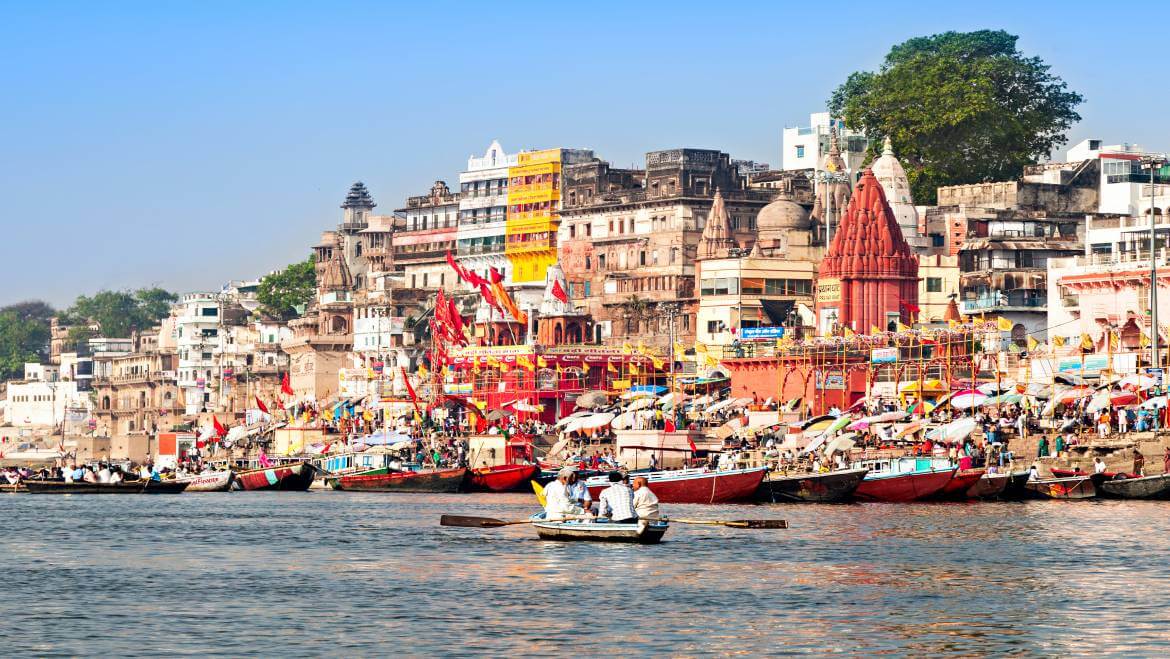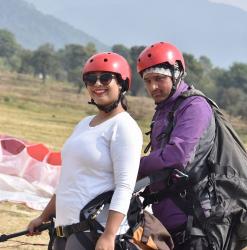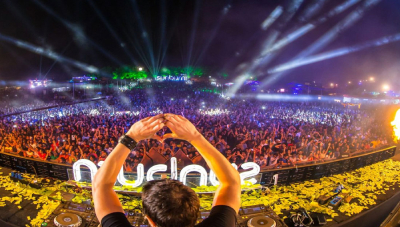The heart of the city of lights or Kashi Varanasi has been beating for 3000 years and its lifeline is its scenic spiritual legacy. It is believed that Lord Shiva founded the holy city of Varanasi. It is the most popular Hindu pilgrimage destination in India. It is truly a representation of authentic India. Varanasi is a center of Hindu renaissance, Sanskrit, Yoga, spiritual and religious heritage. Today, Varanasi is a busy hub, where all winding roads look similar, Ghats are always crowded and the fragrance of incense and the smell of burnt firewood dissolve in the air.
The aartis and the floating of earthen lamps over the water of River Ganga in the evening is also an important element of the identity of Varanasi. It is also an auspicious place for death. It is said that people who die here will be free from the cycle of birth and death. Apart from that the beautiful architectural wonders of the kings of Bengal and Maharajas of Rajasthan makes Varanasi a colorful palette of artistic wonders, faith and rich cultural heritage.
Quick Information and Facts on Varanasi Tourism
| Famous Landmark Destination of Varanasi |
Kashi Vishwanath Temple |
| Best Time to Visit Varanasi |
January to March and October to December |
| Major Festivals of Varanasi |
Dhrupad Music Festival and Ganga Mahotsav (November) and Nag Nathaiya Festival |
| Best Thing to Shop in Varanasi |
Banarasi Silk- It is a worldwide famous product of Varanasi. |
| Famous Shopping Places |
Thatheri Bazaar, Vishwanath Lane, Godowlia Market, Golghar, Dal Mandi Market, Rajan Silk Market |
| Best Cuisines and Street Foods of Varanasi |
Kachori Sabzi, Safed Makhan Toast, Thandai, Laaiya Chana, Chooda Matar,Baati Chokha, Malaiyyo, Tamatar Chaat, Banarasi Paan
|
| Popular Ghats of Varanasi |
Dasaswamedh Ghat, Panchganga Ghat, Manikarnika Ghat, Assi Ghat, Chet Singh Ghat, Tulsi Ghat, Manmandir Ghat, Scindia Ghat, Lalita Ghat |
Let’s embark on a journey of the holy city of Varanasi and show you some of the best places to see.
Best Religious Places to Visit in Varanasi
- New Vishwanath Temple
- Kathwala Temple
- Kashi Vishwanath/ Golden Temple
- Tulsi Manas Temple
- Monkey Temple
- Bharat Mata Temple
- Alamgir Mosque
- Parshvanath Jain Temple
- Kalbhairav Temple
Popular Ghats to Visit in Varanasi
- Dasaswamedh Ghat
- Assi Ghat
- Manikarnika Ghat
- Manmandir Ghat
- Shivala Ghat
- Harishchandra Ghat
- Tulsi Ghat
- Dharbhanga Ghat
- Scindia Ghat
- Ahilyabai Ghat
- Lalita Ghat
- Rana Mahal Ghat
- Chausatthi Ghat
- Panchganga Ghat
Must Visit Historical Sites in Varanasi
- Gyan Vapi Well
- Bharat Kala Bhawan Museum
- Ramnagar Fort
Top Destinations to Visit Nearby Varanasi
- Sarnath
- Prayagraj
- Kaushambi
- Ayodhya
- Betla National Park
- Bodhgaya
- Nalanda
Recommended Tour Packages
Must Visit Temples in Varanasi, Uttar Pradesh
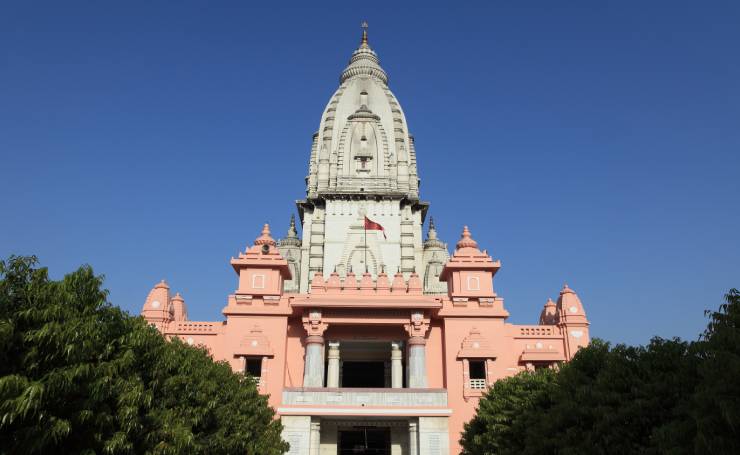
New Vishwanath Temple- Peace Land
Situated in the premises of Banaras Hindu University (BHU), New Vishwanath Temple is definitely a must visit pilgrimage destination in Varanasi. The temple was constructed by the famed Birla family and hence is also known as Birla Temple. In fact, it is a temple complex which consists of 7 temples.
The Shiva temple is situated on the ground floor, whereas Durga temple and Lakshmi Narayan temple are located on the first floor. The architecture of the temple is inspired by the old Vishwanath Temple and the structure is made of white marbles. The walls of the temple are adorned with the text of Gita, which certainly catches the eyes of the visitors here.
Kathwala Temple – Unique and surreal
Kathwala Temple is one of the most popular religious places to see in Varanasi. It is also known as Nepali Temple as it was built by the king of Nepal – Rana Bahadur Shah in the 19th century. It is a brilliant example of exquisite Nepali architecture and wood work called Kath in Nepalese language. Hence, it is known as Kathwali temple. It resembles Pashupatinath temple of Kathmandu. The most interesting thing to see in this temple is its unique Khajuraho style sculptures. It is situated in the Lalita Ghat and catches the attention of many visitors in Varanasi.
Kashi Vishwanath/ Golden Temple – Dipped in spirituality
Kashi Vishwanath Temple is the most popular pilgrimage place to explore in Varanasi. The history of this sacred shrine can be traced back to 3500 years. The temple is one of the 12th Jyotirlingas. It is the first place where the fiery light of Lord Shiva in the form of Jyotirlinga manifested from heaven to the earth. These are considered the holiest Shiva temples. The Linga is the presiding deity here and the temple is a quadrangle, surrounded by temples of other gods. The temple once had a golden spire and domes; hence it was also called the Golden Temple. It was constructed in 1780 by Maharani Ahilyabai Holkar of Indore. It is situated in Kashi Vishwanath Gali, also famous for its shops.
Highlights
- Temple Timings for Sugam darshan – 6:00am to 6:00pm
- Also visit Annapurna Temple, Dundiraj Vinayak and Gyanvapi which are located near Kashi Vishwanath temple.
Tulsi Manas Temple – Reviving the old Bhakti Poet
Your spiritual holidays in Varanasi will be blissful if you visit Tulsi Manas Temple of Varanasi. This temple was built in the honour of the great Indian Bhakti poet Goswami Tulsidas. It was constructed in 1964 with white marble. The architecture of Tulsi Manas Temple will blow your heart away as in its walls the scenes and verses from Ramcharitmanas are engraved. It is believed that the temple is located at a place where Tulsi Das wrote this famous Indian epic. The temple is dedicated to Lord Rama and it is located near another famed shrine called Durga Temple.
Temple Timings: 5:00am -12:00pm and 3:00pm to 9:00pm
Monkey Temple – Epitome of Peace
Monkey is one of the most popular religious tourist attractions in Varanasi. It is dedicated to goddess Durga but is recognized as a Monkey Temple, due to the excessive population of monkeys around it. It also houses a Kund which is believed to be connected with the holy river of Ganga and thus have therapeutic properties. Devotees from all over India visit this temple to seek divine blessings and hear Bhajans and prayers to seek spiritual grace. It is believed the presiding deity was not man-made but appeared on its own. The temple is built by a Bengali Maharani in a Nagara style of architecture. Non-Hindus are allowed to enter the courtyard of the shrine but not the inner sanctum.
Other Interesting Blogs to Read
Bharat Mata Temple – I Love My India
This temple is one of its kinds as instead of being dedicated to any god or goddess, the temple is dedicated to Bharat Mata or India (assumed as Mother). The temple is situated in Mahatma Gandhi Kashi Vidyapeeth Campus. Inaugurated by Mahatma Gandhi in 1936, the temple was an inspiration for those who were fighting the war of independence. The statue in the shrine denotes mountain, plain and ocean and the major highlight of the temple is the relief map of India carved on a marble. The idol of Bharat Mata symbolizes the entire India which makes it one of the best places to visit in Varanasi. The temple was built by Babu Shiv Prasad Gupt. Travelling to Varanasi would be amazing if you visit its peaceful shore.
Temple Timings – 9:30 am to 8:00pm
Alamgir Mosque – Timeless Mosque
Located near Panchganga Ghat, Alamgir Mosque stands still in pride to bless the devotees. The mosque is situated on the edge of River Ganga and enjoys a picturesque scene. Said to be built by Mughal Emperor Aurangzeb who is believed to have demolished the old Kashivishwanath Temple and constructed this mosque in its place; Alamgir mosque is a fine piece of architecture. The mosque is also known as Gyanvapi mosque due to the well of the same name situated close to it. One can notice the influence of North Indian or Hindu architecture in this mosque; however, most of the mosque is done in Islam architecture. This mosque is also known as Dharhara Mosque.
Parshvanath Jain Temple – Sooth your eyes with Serenity
Parshvanath Jain Temple is a must visit religious tourist attraction in Varanasi. The temple is one of its kind. It is dedicated to the 23rd tirthankara (saint) of the Jain religion, Parshavnath. It is the most important pilgrimage destination for the Jain community. The temple is managed by Digambara sect of Jainism. It is said that this is the place where the swayamvar of the daughter of the king of Kashi was held. The temple has beautiful lattice work which will delight the eyes of the devotees.
Kalbhairav Temple – Seek Holy Blessings
Kalbhairav Temple is the most sought-after religious attraction in Varanasi. The temple is dedicated to Lord Bhairav, who is an incarnation of Lord Shiva. It is believed that Lord Kalabhairava decides who stays in Varanasi. This is the reason why people first visit this temple and seek holy blessings. People who leave Varanasi also stop here to take the Lord’s permission. Devotees offer Sesame oil and flowers to the deity. The back entrance of the inner sanctum can only be accessed by the priest. God Kalbhairav is said to be the protector of Sati Pind and no one can touch the Sati Pind without his permission.
Temple Timings – 5:00 am to 1:30 pm and 4:30 pm to 9:30 pm
Other Interesting Blogs to Read
Must Popular Ghats of Varanasi
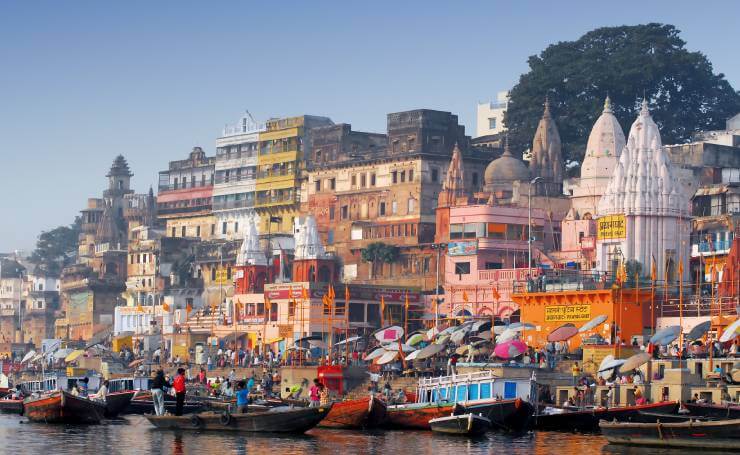
Dasaswamedh Ghat
Reckoned to be the oldest ghat in Varanasi, Dasaswamendha Ghat is where all the action takes place. It is the most popular tourist attraction in Varanasi. The ghat is situated near the Vishwanath temple and is famous for its evening aarti. Often crowded with sadhus, sanayasis, beggars and devotees, this ghat is an important landmark of Varanasi city. During the evening aarti, devotees leave earthen lamps in the water to float creating a beautiful scene which is unmatched.
Highlights
- The most sacred Ghat of Dasaswamedh is famous for its Ganga Aarti. The priest worships the holy river of Ganga which is the lifeline of Varanasi.
- The duration of Aarti is 45 minutes and one must visit this place to experience the divine aura of Banaras. Your holidays in Varanasi would remain incomplete without experiencing the holiness of
- Smaller Diyas are floated by devotees in a leaf platter in the honor of holy river Ganga.
- It is a place where the creator of the universe Lord Brahma sacrificed ten horses.
- The ghat was constructed by Queen of Indore – Ahilyabai Holkar in 1774.
Assi Ghat
This sacred Ghat is situated on the confluence of the River Ganga and Assi. The devotees bathe here prior to paying homage to a huge Shiva Lingam placed under a tree in close proximity to this ghat. It is a must visit tourist attraction in Varanasi. The ghat is situated at the south of the city and therefore is less crowded. However, it doesn’t by any means indicate that the ghat holds any less importance than other ghats.
Highlights
- It is a meeting point of River Ganga and Assi River.
- There is an idol of Lord Shiva which is kept beneath the Peepal tree and it is worshipped by the devotees from all over the world.
- The evening Aarti of Assi Ghat is the center of attraction for devotees. Every evening, priests chant mantras and honor the holy river Ganga.
- The sight of the evening Aarti will blow your heart away. It looks ethereal.
- It is said that Goddess Durga killed the demon called Shumbha- Nishumbha and after killing them she threw her sword in the Assi River.
Manikarnika Ghat
Manikarnika is the main cremation Ghat and is also reckoned to be one of the oldest Ghats in Varanasi. It is also known by the name of Burning Ghat as the dead bodies are burnt here regularly. According to Hindu mythology, Manikarnika Ghat is believed to be the place where the ornament worn by Sati on her ear fell down when Lord Shiva was carrying her to the Himalaya. It is a popular belief here that those who are cremated here get Moksha. It is one of the best places for Sightseeing in Varanasi.
Highlights
- Located between Dasaswamedh Ghat and Scindia Ghat, Manikarnika Ghat is one of the most important places for cremation.
- It is believed that the pond near Manikarnika Ghat was built by Lord Vishnu for Lord Shiva and Goddess Shakti to bathe. There is a footprint of Lord Vishnu near the pond.
- It is said that Goddess Shakti dropped her earring in Manikarnika well. It is here Lord Shiva dug a whole to find the earring, the depression of which was filled with his sweat. This is the reason why Manikarnika well was constructed.
Man Mandir Ghat
Manmandir Ghat is situated north of Dasaswamedh Ghat in Varanasi. The Ghat is reckoned to have been built in the 1600s by Maharaja Man Singh. To the northern corner of the ghat is a fine stone balcony. There are a few famous temples such as Sthuladanta Vinayaka, Rameshwara and Someshwara temples located near this Ghat.
Highlights
- Manmandir Ghat is also known as Someshwara Ghat as the sacred lingam of Lord Someshwar was found here.
- This Ghat is decked with numerous Hindu Deities which makes it the best place to visit in Varanasi for spiritual wisdom seekers.
- From the stone Balcony the mesmerizing views of River Ganga will seduce your senses.
Shivala Ghat
Shivala Ghat is amongst the finest Ghats in Varanasi that very well reflects the historic era. The Ghat is famed for its Shiva Temple that was built in the 19th century by a Nepalese King called Sanjay Vikram Shah. The temple is known for its architectural grandeur and fine craftsmanship. The Ghat is quite popular amidst the devotees who come here to take a dip in the holy water.
Highlights
- Shivala Ghat in Varanasi is one of the offbeat Ghats to visit in Varanasi. It is less crowded and the center of the attraction of this Ghat is its Colony- Shivala Colony.
- It got its name from the guardian deity of Kashi – Lord Shiva.
- Shiva Temple, Brahmendra Math and numerous other Lord Mahadeva Temples, fortress of Oudh Nawab and 19th-century exquisite mansion of Nepali royal, King Sanjay Vikram Singh are the major tourist attractions to see in and around Shivala Ghat.
- Shivratri is the best time to visit Shivala Ghat.
Other Interesting Blogs to Read
Harishchandra Ghat
This ghat is named after the mythological character Raja Harishchandra, who once worked at this ghat. Now, this king is believed to be righteous and truthful and gods were pleased with his humble behavior and thus retrieved his lost kingdom and his dead son. Harishchandra Ghat is one of the two ghats used for cremation in Varanasi and it is reckoned that whoever is cremated here attains Moksha or Salvation.
Highlights
- Harishchandra Ghat is one of the most prominent Ghats of Varanasi for cremation.
- It is said that King Harishchandra worked in this Ghat for the establishment of truth and charity.
- This Ghat houses an electric crematorium.
Tulsi Ghat
This Ghat is named after the great poet Tulsidas, who is believed to be the author of the Hindu epic Ramcharitramanas. It is believed Tulsidas sat on this ghat of the river and wrote a large part of Ramcharitramanas here. There is a big temple here that is dedicated to Lord Rama on this ghat. At Tulsi Ghat many cultural activities also take place and the most popular one is the Krishnalila that takes place in the month of Kartika (Oct/Nov).
Highlights
- It is the place where the great Epic poet Tulsi Das composed Ramcharitmanas in Awadhi.
- It is in Tulsi Ghat where the theatrical performance of Lord Rama’s life was first staged in India.
- Lolark Kund situated here cures people from diseases and blesses the native with long life and progeny.
- There is a small house at the Ghat where Poet Tulsidas used to live. It contains several artifacts of the poet like wooden clogs and an idol of Lord Hanuman.
Dharbhanga Ghat
Situated within close proximity of Dasaswamedh Ghat, Darbhanga Ghat is used for performing the rites and rituals that are related to the demise of a loved one. The ghat has a grand building from where one can see the rituals being performed here.
Highlights
- Located between Chausatthi and Babua Pandey Ghat, it is one of the most serene and popular tourist destinations to visit in Varanasi.
- It holds great religious and spiritual value for tourists. It serves as an open crematorium.
- It is very famous for its sacred Shiva Temple at Nilkantha area and the shrine of Kukkuteswara.
- It is named after the royal family of Darbhanga and they also built a magnificent palace with sandstone from Chunar.
Scindia Ghat
Scindia Ghat, which is also known as Shinde ghat in Varanasi, is famed for the large number of places of worship found here. The Shiva temple at the ghat is a major tourist attraction in Varanasi due to its partial submergence in the water. According to Hindu mythology, this ghat is known as the place from where Agni (Fire) originated. Thus, it is revered as a holy place and many devotees like to visit here.
Highlights
- Scindia Ghat is very popular for its partially submerged Lord Shiva Temple named- Ratneshwar Shiva Temple. It is said that the temple is unable to bear the weight of the Ghat. The temple has a very interesting story behind its submergence.
- According to a tale, a boy named Man singh built a temple of Lord Shiva to pay all the debts he owed to his mother as his mother was in a relationship with a man but the boy disapproved of this relationship. He thought by building a temple he would be able to cut all the ties with his mother.
- His mother was unable to end the relationship with that man so she told his son to cut all ties from her if he is able to do that by paying her debts. Upon visiting the temple his mother was angry and said that One Can never pay off the debts of a mother.
- She cursed this temple and thus this temple remained submerged in water. During Summer the water of the holy river Ganga subside and the sanctum sanctorum of the temple remains visible which makes this temple one of the best tourist destinations to visit in Varanasi.
Ahilyabai Ghat
Ahilyabai Ghat was earlier known as Kevalgiri Ghat but in 1778, the famous Queen Ahilyabai Holkar ordered its renovation and converted it into a ghat that was made of concrete. The Ghat is famous for the fact that it is believed to be the first Ghat in Varanasi that has been named after a person. The best time of the day to visit here is in the morning hours, when the Hindu devotees throng the ghat to take a dip to get cleansed from their sin.
Highlights
- Most of the dead bodies are cremated in Ahilyabai Ghat. It is also known as Burning Ghat.
- Morning is the best time to visit Ahilyabai Ghat for a holy dip into the sacred waters of the Ghat and wash away their sins for salvation.
Other Interesting Blogs to Read
Lalita Ghat
One of the most venerated Ghats in Varanasi, Lalita Ghat is known for its wooden temple of Keshava. The temple was built by the King of Nepal in typical Nepalese architecture. The carvings on the wall depict sceneries and often attract the art lovers. The Ghat is dedicated to Lalita Devi who is reckoned to be the personification of Goddess Durga. Devotees who come to this ghat believe that bathing at this ghat will earn them the blessing of the Goddess and prosperity will seep into their lives.
Highlights
- Lalita Ghat was built by the king of Nepal Rana Bahadur Shah in the 19th century.
- Nepali Temple and Lalita Gauri Temple are the center of attraction of this Ghat.
- The ghat got its name from Goddess Lalita who is the highest form of Goddess Adi Shakti.
- Photography and boating are some of the best ways to relax and rejuvenate your soul in Lalita Ghat.
Rana Mahal Ghat
This ghat was constructed by Raja Rana Jagat Singh, who came to Varanasi as a pilgrim. There is a palace near the ghat, which is believed to be the place where the Maharaja stayed during his pilgrimage. The palace boasts of its rich Rajputana architecture and attracts lots of tourists.
Highlights
- Rana Mahal Ghat is located in the south of Dasaswamedh Ghat.
- The magnificent palace on the Ghat is an excellent example of Rajput art and architecture which will blow your heart away.
- It is one of the Ghats under the ‘Revitalization of Varanasi’ Project launched by the regional tourism department for renovation and resurrection.
Chausatthi Ghat
Chausatthi Ghat is known for its beautiful palace built by King Digbatiya of Champaran, Bihar. The ghat is also known as the shelter of famous Sanskrit scholar Madhusudan Sarasvati. There is a temple complex at the ghat as well, where old images of Kali, folk goddesses, Shiva, Ganesha, and Kartikeya can be seen. On the 12th dark-half of Chaitra (March-April) many pilgrims pay a visit to the Yogini temple and take ritual baths at this ghat. Another occasion of attraction is Holi, on the eve of the festival devotees come to pay homage and perform rituals at the ghat.
Highlights
- The ghat is dedicated to goddess Chausatthi, a form of goddess Kali.
- It is an abode of a sanskrit scholar Madhusudan saraswati who wrote Vedanta Kalpa Latika which is a commentary on Bhagavad Gita.
Panchganga Ghat
This Ghat is reckoned to be the mythical meeting place of five sacred rivers. There are numerous images of the five river goddesses, namely, Ganga, Yamuna, Saraswati, Dhutpapa and Kirana. Many devotees throng this ghat in hopes of attaining blessings from these five goddesses. It is one of the most visited tourist attractions in Varanasi. There are five idols presiding here and each is of black stone. From the Ghat one can see the Alamgir Mosque, which is believed to have been constructed by Aurangzeb.
Highlights
- Some of the best places to visit near Panchganga Ghat are Nepali Temple, Mosque of Alamgir, Yoga Training Center and Scindia Ghat.
Other Interesting Blogs to Read
Popular Historical Sites to Visit in Varanasi
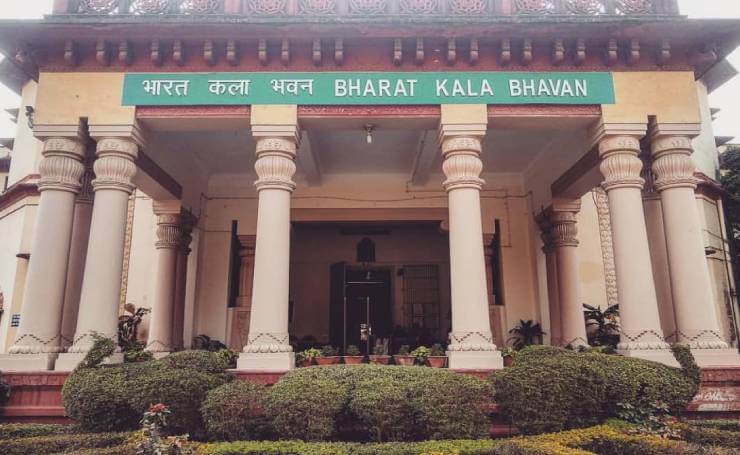
Gyan Vapi Well
Adjacent to the Vishwanath Temple lies the ancient GyanVapi Well (Well of Wisdom). It is believed that the water of this well contains the linga from the original Vishwanath Temple, which was vandalized by Mughal emperor Aurangzeb in the 17th century. The GyanVapi mosque was built by Aurangzeb in the place where this temple was situated.
Bharat Kala Bhawan Museum
To the south of the Vishwanath Temple is Banaras Hindu University, which was founded by Sanskrit scholar, Madan Mohan Malviya. Within the campus of the university is the famed Bharat Kala Bhavan Museum, which is renowned for its rich collection of Indian paintings. The paintings date back to between the 11th century and 20th century and are about 12000 in number. The Mughal miniatures, the sculpture of marriage of Shiva and Parvati and the 11th century statue of Vishnu and the Gandhara sculpture are the major attractions here.
Ramnagar Fort
Ramnagar Fort is situated across the river beyond the Assi Ghat. Built in the 17th century, this fort has been the home to royals of Varanasi for over 400 years. Although almost in ruins today, the palace still retains its charm. One can still witness the ornamented swords, photographs of tiger shoots and visits by the King and Queen of Belgium can be seen decorated on the wall. The Durbar Hall of the fort is converted into a museum, where several objects like palanquins and elephant howdahs are on display. Visiting Varanasi would be incomplete if you haven’t seen the grandeur of Ramnagar Fort Yet.
Other Interesting Blogs to Read
Other Best Places to Visit Nearby Varanasi
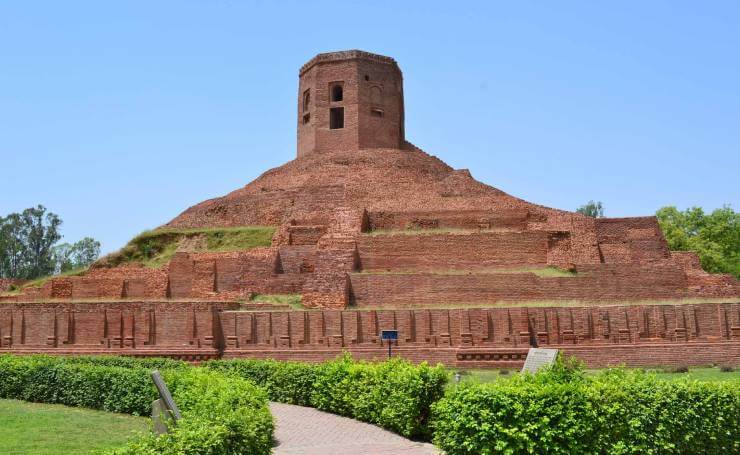
Sarnath
Sarnath is to Buddhists what Varanasi is to Hindus. This city was once the greatest learning center in India and had also been visited by Chinese travelers Fa-Hien and Huien Tsang. The Deer Park is a major attraction in Sarnath; it is believed it is the place where Buddha visited in 528 BC to preach Dharmachakra or the Wheel of Law (his first major sermon after gaining enlightenment). It is one of the most popular tourist attractions to see in Varanasi.
Deer Park is a complex now and the central monument here is Dhamekh Stupa, which is believed to be erected at the place where Buddha delivered his first sermon to five disciples. There is another stupa that catches the attention and it is called Dharmarajika Stupa (built by emperor Ashoka). The complex is dotted with small monasteries and temples.
The Bodhi Tree was also planted here in the year 1931. In Sarnath, one can also visit the Archaeological Museum that displays a wonderful collection of Buddhist artifacts. The major attraction here is the Ashokan Lion Capital in polished sandstone.
Prayagraj
The sacred location at the confluence of three rivers is what makes Prayagraj (Allahabad) a special place near Varanasi. The confluence of Ganga, Yamuna and the mythical Saraswati River has offered Prayagraj cultural and political importance for nearly 3000 years now. Prayagraj, also known as Prayag, became a major centre of the Independence Movement. Today, Prayagraj is a prosperous province and its tree-line avenues and the congested old city offers a commendable contrast.
There are a number of places that catch the attention of visitors in Prayagraj. Prayagraj Fort built in 1583 has a famed Ashokan pillar that was brought from Kaushambi. The eastern side of the fort is famed for the ‘Undying Banyan Tree’ called Akshaivata. Khusro Bagh, Anand Bhavan (ancestral home of India’s premier political dynasty, the Nehru-Gandhi family), Prayagraj Museum, All Saints Cathedral and the Kumbh Mela are the major highlights of Prayagraj.
Kaushambi
Situated about 63kms from Prayagraj, Kaushambi is a place that takes one back in history. According to local legends, the city was built by the Pandavas from Mahabharata. However, excavation revealed that the Buddhist community flourished here between 600BC and 600 AD. At Kaushambi, one can see paved brick roads, small houses, ceramic drains, and the stump of an Ashokan Pillar (3rd century BC). The city is surrounded by green fields and has a river in the background. It is indeed an ideal place nearby to visit from Varanasi.
Ayodhya
Located on the bank of Sarayu River, Ayodhya is reckoned to be the birthplace of Lord Rama. At Ayodhya, one can find a large number of temples that commemorate the birth of Rama. This sacred town remains inextricably linked to the legend of Rama and thus holds a lot of importance.
After the Babri Masjid incident, a makeshift temple has been built, which attracts a large number of devotees especially on the full moon night of Kartik Purnima. Hanuman Garhi is yet another temple that is of utmost importance in Ayodhya. At a short distance from Ayodhya is a city called Faizabad, which is also known as the twin city. Here one has the opportunity to visit Jama Masjid, tomb of Bahu Begum (wife of Shuja-ud-Daula) and a rose garden.
Betla National Park
Situated at a distance of about 290kms from Varanasi, Betla National Park is situated on the Chhota Nagpur Plateau in Jharkhand. Boasting of a rich variety of flora and fauna, this national park was initially known as Palamau Wildlife Sanctuary.
The Park is dotted with bamboo and sal groves; towering mahua (local alcohol is prepared from the flowers of this tree) also covers a major part of the forest. Betla is home to elephants, leopards, tigers and several species of birds.
There are many watch towers and hides that are meticulously deployed around the water holes for offering better opportunity to spot animals here. The Park also has two 16th century forts, a few hot springs and tribal villages inside its premises.
Bodhgaya
The most sacred site for Buddhists, Bodhgaya is situated about 255kms from Varanasi. It is reckoned to be the place where Buddha attained enlightenment. The Mahabodhi Temple is the major attraction of Bodhgaya; this temple is recognized by its soaring pyramidal spire.
In the temple, the image of Bodhi Tree can also be seen. The tree is believed to be the one under which Buddha meditated before attaining enlightenment. In Bodhgaya, there are a number of temples and monasteries that are worth seeing; the Thai Temple, Japanese Temple, Bhutanese and Tibetan Monasteries are established here by devotees from China, Japan, Taiwan, Korea, Bhutan and Nepal. The Archaeological Museum in Bodhgaya is also worth seeing. The museum has beautiful 3rd century BC temple railings, bronze and stone images that date back to the 8th-12th century.
Nalanda
Nalanda was once reckoned to be the most prestigious center of learning in India. Situated at a distance of 355kms from Varanasi, Nalanda in Bihar definitely deserves a visit. The Buddhist University established here in Nalanda is believed to have been established around 5th century AD and had 5000 students both domestic and foreign. There were over nine million manuscripts in its library.
It is also believed that Buddha visited and stayed here in Nalanda quite often. Despite its vandalization by Turkish invader Bakhtiar Khalji, this university still conveys a distinct impression of the serene and disciplined life of contemplation and learning that once prevailed here. Nalanda’s temple; Votive Stupas (they have several images of standing Bodhisattvas and seated Buddha); Monk’s cells, monasteries and Dado panel from Temple 2 are the major attractions here.
Other Interesting Blogs to Read
Varanasi has been an important pilgrimage center in India. If you are planning to visit any spiritual destination in India then Varanasi is a perfect place to be in. Be it food, culture and religious heritage – It gives ethereal vibes. We hope this blog helps you in planning a wonderful spiritual and enjoyable holiday in Varanasi. If you have any query, you can ask in the comment section.
Important Uttar Pradesh Tourism Links
Like & Follow our social media accounts at Twitter, Facebook, Linkedin & Instagram for getting the latest updates & offers on holiday packages.
Disclaimer: We do not take credit for some of the licenced paid images used in our blogs, whether from Google Images, Fotolia & Shutterstock. All such images are the copyrights of their respective owners and we try to provide credit for them wherever we can. If, however, any copyright image has been used on our blog, the concerned person can either mail us directly to remove the image or provide credit to whomsoever the image may belong to.
Frequently Asked Questions
Q.What are some useful tips to follow to enjoy the tourism in Varanasi?
- Dress decently while you are at religious places and Ghats.
- You can arrange shopping and boat tours in advance because there are so many places for shopping and numerous Ghats. These might overwhelm you.
- Beware of bulls while walking down in alleyways and streets.
- If you are trying Bhang Lassi, purchase it from a government approved shop.
- Keep your belongings safe, Varanasi is a crowded place.
- Do not take pictures of the cremation Ghats.
- Boat tours are very costly, you need to negotiate a little to enjoy the tour.
Q.Is Varanasi safe for solo women travelers?
Yes, Varanasi is absolutely safe for solo women travelers but one needs to take precaution at night. At night Varanasi hawkers might overwhelm you as the place is too crowded. If you are planning a trip for evening then team up with someone or a licensed tour guide. Also, keep your belongings safe.
Q.What are the top pilgrimage tourist destinations to visit in Varanasi?
Top Pilgrimage tourist destinations to visit in Varanasi are -
- Ganga Ghats
- Kashi Vishwanath Temple
- Gyan Vapi Kup
- Bharat Mata Mandir
- Sarnath
- Batuk Bhairav Mandir
- Nepali Temple
- Chinese Temple
- St Mary’s Church
- Tulsi Manas Temple
- Durga Temple
Q.What are the best places for shopping in Varanasi?
Best places for shopping in Varanasi are:
- Thatheri Bazaar
- Vishwanath Lane
- Godowlia Market
- Golghar
- Dal Mandi Market
- Rajan Silk Market
- Gyanvapi
- Lahurabir
- Chowk and Urban Hatt
- Banaras Art Gallery
Q.Where to stay in Varanasi?
There is no dearth of places to stay in Varanasi, depending on your budget and choice there are plenty of places available which will delight your wanderer soul and enable you to enjoy the best of Varanasi Tourism.
About the author
From the Lake District, Nainital, Nidhi Singh is a travel writer whose love for mountains can be seen in her write ups. Talk about solo travelling, indulging in adventure activities, binging on good food, planning budget trips or the Aurora Borealis and you will get all her attention. It is the wanderlust that keeps her going and if at all she could get one wish granted she would love to live a life less ordinary. Follow her on Twitter, Facebook & Instagram.

 +91-9212777225
+91-9212777225 Plan Your trip
Plan Your trip